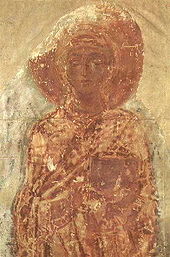Thecla of Iconium

According to the apocryphal records of the Acts of Paul , Thecla of Iconium was a holy virgin and a disciple of the Apostle Paul in the first century. She is venerated in the Catholic Church as a saint and in the Orthodox Churches as an apostolic equality and proto-martyr . Her feast days are September 23 (Catholic), September 24 (Orthodox) and July 26 ( Old Jerusalem Liturgy ). Her attributes are the lion , wild animals in general and the pyre .
Lore
Only the acts of Paul and Thekla from the 2nd century with legendary elements report about Thekla . The files tell of a distinguished virgin from Iconium who heard the apostle Paul and followed him. She gained entry to the prison. As a result of the vow of a virgin life for Christ's sake, she was cast out by her family and bridegroom and denounced as a Christian . When she was executed, she was miraculously saved from the wild animals. After the death of the apostle Paul, she lived as a hermit in a cave near Seleukia on the Kalykadnos until old age .
The historical core of this tradition is disputed. The Viennese coptologist Hans Förster considers it at least “not impossible” that there was a Thecla in Iconium, which was converted to Christianity by Paul. Carl Schmidt, on the other hand, believes that even the often claimed “historical core still belongs to the legend”.
Impact history
The Acts of Paul and Thekla have been translated into several languages such as Coptic , Syrian , Armenian , Ethiopian , Arabic and Latin . Several surviving manuscripts testify to the widespread use of this text. The files are first mentioned in Tertullian . He criticizes the fact that a woman teaches and baptizes and evaluates the files as a forgery:
“If those [women] who (invoke) the falsely written acts of Paul to defend the permission for women to teach and baptize using [the example of Thekla], they may know that the presbyter is in Asia who produced this writing as if he could add something of his own to Paul's reputation, resigned from his office after being convicted and confessed that he did it out of love for Paul. "
Other church writers show a high degree of appreciation for the witness of the faith in their texts. From the second half of the 5th century comes the Vita et miracula S. Theclae , which is based on the files and reports on miracles at the tomb of the saints. These may have been written by the Orthodox Bishop of Seleukia, Basil . In Seleukia, at the place where Thekla is said to have taught and baptized, a well-known place of pilgrimage developed in late antiquity , today called Ayathekla . An equally important place of pilgrimage is a cave (Arabic Mağarat Mār Taqlā) in the Syrian mountain town of Maalula ( Monastery of Saint Thekla ). Paul Heyse published a verse novella in hexameters in 1858, which is based on the tradition of the Thekla of Iconium.
literature
- Karl Schlau : The Acts of Paulus and Thecla and the older Thecla legend : a contribution to Christian literary history, Hinrichs, Leipzig 1877.
- Richard Adelbert Lipsius : The apocryphal stories of the apostles and legends of the apostles , 2nd volume 1st half. Schwetzschke and Son, Braunschweig 1887.
- Richard Adelbert Lipsius, Maximilian Bonnet: Acta apostolorum apokryphae vol. 1 , Hermann Mendelsohn, Leipzig 1891. Greek and Latin text.
- Edgar Hennecke : Handbook on the New Testament Apocrypha in conjunction with specialist scholars, Tübingen 1904.
- Gilbert Dagron: Vie et miracles de Sainte Thècle. Texts grec, traduction et commentaire. (Subsidia hagiographica; Vol. 62). Societe des Bollandistes , Brussels 1978.
- The deeds of Paul and Thecla . In: Wilhelm Schneemelcher (Ed.): New Testament Apocrypha . Volume 2. Tübingen 1989.
- Stephen J. Davis: The Cult of Saint Thecla. A Tradition of Women's Piety in Late Antiquity. (Oxford early Christian studies). Oxford University Press, New York 2001, ISBN 0-19-954871-4 .
- Scott Fitzgerald Johnson: The Life and Miracles of Thekla. A Literary Study. (Hellenic Studies; Vol. 13). Center for Hellenic Studies, Washington, DC 2006, ISBN 0-674-01961-X .
- Claudia Nauerth, Rüdiger Warns: Thekla. Your pictures in early Christian art. (Göttinger Orientforschungen / 2 = studies on late antique and early Christian art; vol. 3). Harrassowitz, Wiesbaden 1981, ISBN 3-447-02171-3 .
- Veronika Niederhofer: Conversion in the Paulus and Theclaacts. A narrative form of Paul’s reception. Mohr Siebeck, Tübingen 2017, ISBN 978-3-16-155143-7 .
- Klaus-Gunther Wesseling : Thekla. In: Biographisch-Bibliographisches Kirchenlexikon (BBKL). Volume 11, Bautz, Herzberg 1996, ISBN 3-88309-064-6 , Sp. 806-814.
- Paul Heyse : Thekla. A poem in nine songs, Cotta, Stuttgart 1858.
Web links
- Carl Holzhey: The Thekla files. Their dissemination and assessment in the church (= publications from the Church History Seminar Munich. II. Series, number 5). Verlag der JJ Lentner'schen Buchhandlung, Munich 1905 ( online , with German translation).
- The Life of the Great Martyr Thecla of Iconium. The Acts of Paul and Thecla. St. Pachomius Orthodox Library, 1995.
Individual evidence
- ↑ Charles Renoux: L'Hymnaire de Saint-Sabas (Ve-VIIIe siècle) , Vol 2 (Patrologia Orientalis 53, 1), Turnhout 2015 565 Note 1...
- ^ Hans Förster: Transitus Mariae . Contributions to the Coptic tradition, Berlin, Walter de Gruyter 2006, p. 201.
- ^ Carl Schmidt: Acta Pauli . From the Heidelberg Coptic papyrus manuscript No. 1, reprint: Hildesheim, Georg Olms Verlagsbuchhandlung 1965, p. 206.
- ↑ Boerleffs, CChrSL, 1, 1954, p. 291f., Quoted from Schneemelcher p. 195, orthography adapted.
| personal data | |
|---|---|
| SURNAME | Thecla of Iconium |
| ALTERNATIVE NAMES | Thecla; Tecla; Tekla; Thekla |
| BRIEF DESCRIPTION | catholic saints; Protomartyr, virgin, hermit |
| DATE OF BIRTH | 1st century |
| DATE OF DEATH | 1st century or 2nd century |

